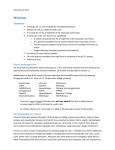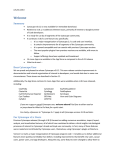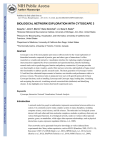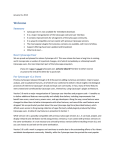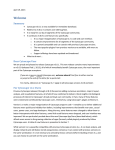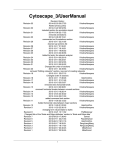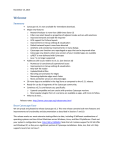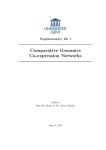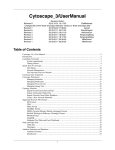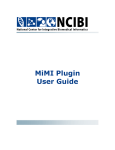Download Welcome Letter ytoscape
Transcript
May 27, 2014 Welcome Summary Cytoscape v3.1.1 is now available for immediate download. It addresses 46 issues relative to v3.1: o Several small issues with new filter facility, including reverting topology filers to pre-v3.1 behavior o Improved network and attribute imports for Excel, CSV, and TXT files o Occasional hangs during startup, shutdown, circular layout, and session load o Better user and App Developer documentation o Feature improvements for exporting networks to web pages 9 more Apps are available in the App Store as compared to the v3.1 release. It is ready for use by all segments of the Cytoscape community. It continues v3.1’s core feature set, specifically: o It is upward compatible and can coexist with previous Cytoscape versions o The most popular plugins from previous versions are available, with more to follow. What to do next … Release notes: http://www.cytoscape.org/releasenotes.html Dear Cytoscape User We are proud and pleased to release Cytoscape v3.1. This new release contains both new features and improvements to functionality and documentation, all of which are described in Section 11. Additionally, v3.1, 11 Apps were added to the App Store, bringing the total to 53. The new ones include: AllegroLayout BridgeDB chemViz2 clusterMaker2 Cyrface CytoCopteR KDDN Rene setsApp Variation WormPlot If you are a new or casual Cytoscape user, welcome aboard! Feel free to either read on or jump ahead to What to Do Next for a quick start. For clarity, references to “Cytoscape 3.x” apply to all Cytoscape versions 3.0.0 and later. For Cytoscape v2.x Users Previous Cytoscape releases (through v2.8.3) focused on adding numerous annotation, import, layout, analysis, and visualization features, all of which have combined to deliver critical insights into biological processes of interest to Cytoscape’s broad and loyal user community. In fact, many of these features were created and contributed by Cytoscape users, themselves, using Cytoscape’s plugin architecture. Version 3.0 marked a major reorganization of Cytoscape program code – it enabled us to deliver additional features more quickly and reliably than before, including improvements that benefit new users, casual users, power users, and app developers. Along the way, some features were changed to allow them to better interoperate with other features, some little-used features were dropped, and user interface was improved. We were particularly excited about the new Cytoscape App Store (described below), which afforded users access to the growing collection of apps (formerly called plugins) produced by fellow Cytoscape users. A table of new features is presented in Section 7. Since v3.0, we released updates v3.0.1 and v3.0.2 as maintenance releases, and then v3.1 as a feature release, including greatly improved visual styles, node filtering, and web publishing. While all version 3 releases are upwardly compatible with previous Cytoscape versions (i.e., they can load, analyze, and display networks and attributes stored using previous versions, including v2.x), they can coexist with previous versions on the same workstation. It is not necessary to uninstall previous versions before installing a version 3 release, and you can choose to use both on the same workstation. Version 3 is still a work in progress and continues to mature due to the outstanding efforts of its vibrant worldwide development community. Notably, while the Cytoscape team has ported the most popular plugins (as apps) from previous versions, porting less popular plugins was deferred so as to deliver version 3 sooner and with features that support cutting edge investigation. A table of apps and their status is presented in Section 8. Finally, we recognize that with all new software (including version 3), there are growing pains. While we hope our users will learn to love v3’s new features, users may also expect to relearn rationalized features and occasionally uncover a bug. With version 3.0, we are rolled out new manuals, tutorials, web pages, and support channels that we hope can create and maintain highly productive experiences for all types of Cytoscape users. We continue to improve these materials monthly. A table describing Cytoscape support is presented in Section 9. We are very excited to make this release, and hope you find it an indispensable tool in your research. To get you started, we have provided additional introductory material to get you started on the right foot, and we have also provided background material for general interest. Please let us know how we’re doing and how we can better advance your research! The Cytoscape Team What to Do Next We hope to help you use Cytoscape in the most productive way. Your next steps depend on how experienced you are with Cytoscape and what you would like to do. In the table below, please find the category that best describes you, and proceed accordingly. Type of Cytoscape User New Casual Power App Developers General Interest Where to Read Next For New Users (Section 1) For Casual Users (Section 2) For Power Users (Section 3) For App Developers (Section 4) Try getting oriented by reading: General Background (Section 5) Cytoscape App Store (Section 6) Then try browsing: New Features (Section 7) App Status (Section 8) Support Offering (Section 9) Future Plans (Section 10) To get your feet wet, try: For New Users (Section 1) 1. For New Cytoscape Users What is Cytoscape? Cytoscape is software that can help you visualize complex networks (as graphs) representing relationships between genes, proteins, or other entities. Cytoscape tracks and displays these entities (as graph nodes) and relationships between them (as graph edges). Cytoscape, per se, does not assign meaning to either nodes or edges – you can assign your own meanings to them, and you can add your own node or edge attributes (e.g., name, measurements, states, etc.) that customize your graph to represent semantics important to you. While Cytoscape provides simple analytics and visualizations, others are available as apps from the Cytoscape App store (see Section 6). What Do I Need Before I Can Use Cytoscape? At the very least, you must provide Cytoscape with a list of nodes. You can also provide a list of edges and attributes. You can enter your graph manually or import it from your own files – Cytoscape supports a wide variety of file formats, including text and Excel. Cytoscape can also load pre-configured networks (e.g., from BioGRID) so you can leverage them without having to enter them yourself. Can Cytoscape Help Me Get Started? Yes! The Cytoscape team had provided many resources tailored for all kinds of users (see Section 9). To start, there is an Installation Guide and numerous tutorials. Once you load your graph, you may find additional useful analytics and visualizations at the App Store (see Section 6). Which Cytoscape Version Should I Use? Generally, you should use v3.1.1 (the newest version). v2.x has been in the field for several years and will be supported into the future, but over time, v3.x and successors will be better supported. Note that if you have already installed v3.0.0, v3.0.1, v3.0.2, or 3.1, you can install v3.1.1 without uninstalling your previous version. How to Download and Install v3.x Surf to http://www.cytoscape.org, click on the Download Cytoscape button, and follow the prompts Be sure to consult with the Release Notes (viewable via the Release Notes button) for issues and solutions pertaining to your installation Surf to http://www.cytoscape.org, click on the Release Notes button, click on a User Manual link, and follow the instructions in the Launching Cytoscape section. 2. For Casual Cytoscape Users If you’re confident of your Cytoscape skills, please read the Power Users information (Section 3). If you’re Cytoscape skills are rusty, please continue with the New Users information (Section 1). 3. For Cytoscape Power Users Is v3.x for Me? The answer is most likely yes, provided you use the apps (formerly known as plugins) available for v3.x – apps are available from the new Cytoscape App Store, which you can browse directly (Section 6). Note that some v2.x apps have been incorporated directly into Cytoscape and need not be downloaded or installed. Consult the Apps Status table (Section 8) to see a list of these apps. Note that v2.x plugins are not compatible with v3.x apps, and vice versa. If you rely on v2.x plugins that are not yet available for v3.x, you may need to remain with v2.x instead of upgrading to v3.x. Note, also, that the Cytoscape community is converting v2.x plugins to v3.x apps -- you might occasionally revisit the App Store to see if an app you need becomes available. What’s New in v3.x? As described in the Welcome letter (above), v3.x incorporates a number of new features (Section 7) and productivity enhancing support offerings (Section 9), including the Cytoscape App Store (Section 6). The General Background section (Section 5) describes the rationale, advantages, and issues with v3.x. Will Support for v2.x Continue? Cytoscape v2.x will be supported by the Cytoscape community for now, but with fewer upgrades and support options over time. Can I use v2.x and v3.x at the Same Time? You can experiment with v3.x by installing it on your workstation – you can use both v2.x and v3.x on the same workstation. How to Prepare for v3.x 1. If you have already installed a v3.1.1 beta version, please uninstall it before proceeding. The Cytoscape v3.0 and v3.1x versions can coexist with v3.1.1, and do not need to be uninstalled. 2. Consult the Apps Status table (Section 8) to verify that the apps you need are available. Some apps have become part of the Cytoscape core, and you won’t need to download them. Other apps are available in the Cytoscape App store (described in Section 6). 3. Browse the New Features table (Section 7) to see what we have added since v2.x. 4. Browse the Future Plans table (Section 10) and Support Offering table (Section 9) to see where the Cytoscape community is going. How to Download and Install v3.x Surf to http://www.cytoscape.org, click on the Download Cytoscape button, and follow the prompts Be sure to consult with the Release Notes (viewable via the Release Notes button) for issues and solutions pertaining to your installation Surf to http://www.cytoscape.org, click on the Release Notes button, click on a User Manual link, and follow the instructions in the Launching Cytoscape section. 4. For Cytoscape App Developers Cytoscape manages graph storage and display, and contains a number of common analytic and visualization functions. App Developers may write apps (formerly known as plugins) to perform problem-specific analytics, graph layouts, or other visualizations. Before starting app development, you should be familiar with overall Cytoscape usage and functionality – see the Power Users section (Section 3) to start working with v3.x if you have not already done so. Note that v2.x plugins do not work with v3.x. In order get the benefits of improved stability, the Cytoscape team found it necessary to change the relationship between plugins/apps and the Cytoscape core. Many plugins have been ported to v3.x (see Section 8). The porting exercise is substantial, and once a plugin is converted to an app, it will continue to work at least until v4.0 is released – there is no v4.0 planned at this time. For more on this topic, see: http://wiki.cytoscape.org/Cytoscape_3/CoreDevelopment/Motivation Should I Convert My v2.x Plugin to a v3.x App? Yes! Cytoscape v2.x will be supported by the Cytoscape community for now, but with fewer upgrades and support options over time. How Do I Get Started With App Development? To get started with app development: http://wiki.cytoscape.org/Cytoscape_3/AppDeveloper To convert a v2.0 plugin to a v3.x app, refer to: http://wiki.cytoscape.org/Cytoscape_3/AppDeveloper/PluginPortingGuide For a broader view of the Cytoscape system (including the Core), refer to: http://wiki.cytoscape.org/Cytoscape_3/CoreDevelopment Are there App Samples? Yes! See: http://opentutorials.cgl.ucsf.edu/index.php/Tutorial:Creating_a_Simple_Cytoscape_3_App Also note the App Cookbook: http://wiki.cytoscape.org/Cytoscape_3/AppDeveloper/Cytoscape_3_App_Cookbook 5. General Background The overall mission of Cytoscape is to be a freely available worldwide asset supporting network analysis and visualization for systems biology science. The major focus of v3.x is the modularization and rationalization of code to solve stability issues in v2.x encountered as multiple developers pursued multiple agendas. Under v2.x, internal programmatic interfaces evolved from one release to the next, leading to the failure of working plugins over time and negative interactions between otherwise working plugins. Ultimately, this resulted in loss of programmer and user productivity, and undermined community confidence in Cytoscape. v3.x addresses these issues by adopting modular coding practices promoted by the OSGi architectural framework1. This enables both the Cytoscape core and externally developed apps (formerly called plugins) to evolve independently without compromising unrelated functionality. At the logical level, Cytoscape leverages OSGi precepts to produce v3.x APIs having cleaner and clearer demarcations between functional areas. At the deployment level, OSGi enables on-the-fly substitution of one processing element for another (e.g., apps) in order to tailor Cytoscape to meet user requirements at runtime without reinstalling or reconfiguring Cytoscape. Creating v3.x occupied an international team of engineers for over a year, and represents a strong investment toward reducing future development and support costs, and increasing reliability and evolvability. With the completion of v3.x, we expect to leverage v3.x as a platform to satisfy the evolving needs of multiple stakeholder groups, and as a platform enabling research on leading edge analysis and visualization techniques. v3.x is the intended successor to v2.x, with development and support of v2.x expected to diminish and disappear over time in favor of v3.x. We believe that users will benefit most directly from the v3.x by: experiencing fewer core and app bugs from one release to the next the availability of more and richer apps (due to developers spending less time tracking and fixing bugs) more core features with higher biological and logistical value (due to improved flexibility provided by interface-driven development) During the creation of v3.x, a number of features were added, as listed in the New Feature Table below. As a result, we incurred a number of current and future costs: Cost Slower startup time Loss of plugins 1 Reason OSGi module inventorying Lag in upgrading less popular plugins Time frame for addressing near-to-medium term as needed www.osgi.org – also used as the basic framework for Eclipse and numerous commercial products 6. The Cytoscape App Store The Cytoscape App Store is new in v3.x and targets broad demographics through specific features: Cytoscape User New or Casual Power or Frequent Plugin Developers Benefit Find Cytoscape functionality easier via familiar paradigms of search and tag navigation Find and install apps easier and provide crowdsourced rating and reviews Have a dedicated presence for their work, including a direct line to their users and critical statistics to justify their development on the Cytoscape platform. Furthermore, the App Store supports contests and social incentives that encourage critical technical and community development, including porting, analytics, rating/reviewing, and so on. Note that the App Store supports only Cytoscape v3.x and does not contain plugins compatible with earlier Cytoscape versions. Likewise, plugins that work with earlier versions are not compatible with v3.x – Section 8 contains a list of apps available for v3.x. To access the App Store, access Cytoscape’s new Apps menu and choose the App Manager menu item, or use your browser to surf directly: http://apps.cytoscape.org 7. New Feature Table Feature Welcome screen Beneficiary New users (for solicitousness), casual and power users (for convenience) All users Manual Section 5.1. Welcome Screen 23. Cytoscape.js and Cytoscape 17.2. Merging Tables 24. Scripting New filter facility Power users wanting to present networks on web pages Users of attributes in multiple tables Power users creating repeatable workflows Power users using other applications to communicate with Cytoscape All users Group annotations Automatic citations Improved PSICQUIC access Users with highly annotated networks Users publishing Cytoscape analyses 5.3.8 Help All users needing to download protein databases New Style replaces VizMapper Export to cytoscape.js Merge columns Command line interface REST interface 14. Styles 12. Finding and Filtering Nodes and Edges 8. App Status Table For the most up to date list of apps, see the App Store (described in Section 6). A URL for our development list is shown below, as a list of apps and their status at the time this letter was authored. https://docs.google.com/spreadsheet/ccc?key=0ArzUWDuvdBndDI0R0kwOERjN1ZhcDZseC00dVZNNlE&authkey=CMGe99EM#gid=0 Apps new since the v3.1 release are highlighted in yellow. App addParentNeighbors AdvancednetworkMerge AgilentLiteratureSearch AllegroLayout AllegroMCODE APCluster APID2NET bayelviraApp BiLayout BiNGO bioCycPlugin BiogridPlugin BiomartClient BioNetBuilder Capability For a selected node in child network, adds neighboring nodes from a parent network . Merges multiple networks. Mines scientific literatures to find ones related to search term and to create interaction network based on the search result. High-speed and high-quality layout app designed for large-scale networks Very fast clustering based on MCODE algorithm. Uses affinity propagation described in Frey BJ and Duec D (2007) to perform clustering. Downloads PPI data from http://bioinfow.dep.usal.es/apid/ and performs various analyses including protein motif, GO, hub identification, etc. through the original GUI. Equipped with impressing "rainbow" coloring of nodes. Builds Bayesian networks using a file of patterns as input data using Naive Bayes, Semi Naive Bayes, Selective Naive Bayes, TAN, KDB and Class Tree Naïve algorithms. Finds a bipartite network for two sets of user-selected nodes and performs layout. Calculates overrepresented GO terms in the network and display them as a network of significant GO terms. Loads any pathway in bioCyc database. Original panel provides useful information for each node. Loads Biogrid tab file onto Cytoscape. Retrieves attributes associated with given gene or protein Through the wizard, user can easily construct networks from public databases. User can also create interologs. Status Available in App Store Available in App Store Available in App Store Available in App Store In Progress BioQualiPlugin Bisogenet BLAST2similarityGraph BridgeDB CABIN CalculatenodeDegree CentiScaPe ChemViz ClojureEngine ClueGO CluePedia clusterExplorerPlugin clusterMaker2 ClusterONE ClusterViz commandTool CommFinder Commonattributes CoNet Performs consistency check of regulatory network and expression data. Retrieves interactions associated with input IDs. Sophisticated UI gives links to GO, KEGG, etc. Visualizes BLAST similarity as graph. Performs identifier mapping services based on various resources Integrates interaction datasets from different resources to explore the integrated network and to perform confidence analysis for interactions. User can give weight to each interaction set which will be used for the level of confidence. Simply calculates degree for selected single node. Calculates topological characteristic values (ex. Centralities) for each node. Visualizes chemical structure of each compound in chemical network with original interface. Provides Clojure API. Creates and visualizes a functionally organized GO term network or pathway from given interaction network. Pathway insights using integrated experimental and in silico data Explores a given similarity graph. Clusters densely connected nodes and node attributes (i.e. expression data) in a given network. Results of these two types of clustering can be analysed in the integrated interface. Finds overlapping protein complexes in a protein interaction network. Clusters are visualized by original interface with their pvalues. Clustering based on FAG-EC, EAGLE or MCODE. Found cluster can be subjected to GO enrichment analysis. Provides simple command-line interface to Cytoscape. Clustering based on QCUT, HQCUT, MCL, MCODE. Find attributes shared between selected nodes. Clustering based on FAG-EC, EAGLE or MCODE. Found cluster can be subjected to GO enrichment analysis. Available in App Store Available in App Store Available in App Store Available in App Store Available in App Store Available in App Store Available in App Store Available in App Store Available in App Store ConsensusPathDBplugin Cy3 Performance Reporter CyAnimator CyClus3D CyGoose CyKEGGParser Cyni Toolbox CyOog CyPath2 Cyrface CyTargetLinker CyThesaurus-ID-Mapping CytoCluster CytoCopteR cytoHubba CytoKegg CytoNCA Cytoprophet CytoSaddleSum CytoscapeRPC Retrieves interaction evidences for given pair of genes or proteins Collects information about Cytoscape 3 performance Creates animation based on added frames of network views. Clusters a given network based on threenode motifs. Accepts multiple types of interactions. Cluster ID is given to edge attributes, "EdgeCluster". Provides Gaggle Boss, which routes data from one application to another. Parses and increases accuracy and specificity of KEGG pathways. Network Inference Toolbox for inferences from bio-data. GUI client app for Pathway Commons 2 (BioPAX L3 pathway data) web service. Establishes an interface between R and Cytoscape by using different Java-R libraries Extends biological networks with regulatory interactions. Performs ID mapping using BridgeDb and other public or custom database sources. Analyze and visualize clusters from network. Friendly way to use CellNOptR taking advantage of the network visualization and analysis of Cytoscape and without requiring knowledge on R Predicts and explores important nodes and subnetworks in a given network by several topological algorithms. Identify Kegg pathways associated to specific expression profiles. Providing calculation, evaluation and visualization analysis for several centralities of weighted and unweighted network. Finds enriched function based on sum-ofweight scores. Allows user to query and modify networks through an XML-RPC connection. Available in App Store Available in App Store Available in App Store Available in App Store Available in App Store Available in App Store Available in App Store Available in App Store Available in App Store Available in App Store CytoSEED CytoSQL DisGeNET DomainGraph DroID D3.js Exporterer dynamicXpr DynNetwork edgeLengthPlugin edgeLister Enhanced Graphics EnhancedSearch EnrichmentMap eXamine ExprEssence ExpressionCorrelation FERN FluxViz Enables users to view, manipulate and analyze metabolic models created by the Model SEED. The reactions are organized into a set of maps based on each reaction's membership in KEGG pathways. Retrieves attributes from SQL databases by invoking query command. Queries and analyzes networks of diseases and their associated genes. Visualizes domain-domain interactions which connect pairs of interacting proteins. Retrieves interactions associated with input IDs. Detailed information associated with interactiong proteins can also be obtained. Export Cytoscape network and table as D3.js style JSON Dynamically change colors of nodes like a movie according to their expression level across many conditions. Visualize dynamic networks. Calculate edge length in the main network view window, and stores them as edge attributes "length". Records selected edges and provides some functionality for them (ex. hiding recorded edges) Passthrough mapper for charts and gradients. Performs keyword search. Wildcards, logical operators, etc. are allowed. Visualizes enrichment of specific functions (GO terms) by interactions between functions. Set-oriented visual analysis approach for annotated modules that displays set membership as contours on top of a nodelink layout. Searches for differentially altered links in a given network using multiple set of expression data. Makes a similarity network where nodes are genes, and edges denote highly correlated genes. Performs stochastic simulation of chemical reaction networks. Visualizes fluxes as visual effect to edges on Cytoscape network. Available in App Store Available in App Store Available in App Store Available as part of core Available in App Store FM3 FunNetViz Gasoline GeneMANIA GenomeSpace Genoscape GFD-Net GIANT GoogleChartFunctions GPML-Plugin GraphletCounter GraphMLReader GroovyEngine GroovyScriptingEngine GroupTool HiderSlider HyperEdgeEditor HyperModules IgraphPlugin IntActWSClient Performs one of the fastest multilevel force directed Layouts called FM3 Layout introduced by Hachul S et al 2005. Integrates and visualizes co-expression network with biological role of transcripts (e.g., GO terms). Centrality measures are equipped. Multiple local alignment of protein-protein interaction (PPI) networks. Generates interaction networks from public databases based on user's list of genes. Also provides annotation and putative function for those genes. Enables communication with GenomeSpace Analyze a gene network based on Gene Ontology (GO) and calculate a quantitative measure of its functional dissimilarity. Network analysis according to the Guimerà-Amaral cartography Creates image from attribute values (URL) using the Google Chart API. Enables import of GPML file via import menu. Calculates "graphlet" (small connected nonisomorphic subgraph) degree distribution. Loads interactions or pathways in GraphML format. Provides scripting interface of Groovy. Provides scripting interface of Groovy. Enables user to defines groups of nodes. For each group, basic information such as number of nodes will be displayed on the panel. Provides user sliders which can hide nodes whose continuous attribute is below threshold specied by sliders. Enables one to create hyper-edge by Cytoscape editor. Uses local graph search heuristics to detect closely connected gene network regions in which gene mutations correlate with clinical features. Brings some functionality of Igraph such as layouts into Cytoscape. Mac only. Retrieves interactions associated with input IDs. Available in App Store Available in App Store Available in App Store Available in App Store Available in App Store Available as part of core In Progress Available in App Store Replaced by PSICQUIC Interference iRefScape jActiveModules JavaScriptEngine JEPETTO KDDN KEGGscape KeyPathwayMiner KGMLReader mcl-new MCODE MetaNetter MetanodePlugin2 MetDisease MetScape MiMIplugin Evaluates the topological effects of single or multiple nodes removal from a network using the effect to Radiality, Closeness, Betweenness, Centroid Value and Eccentricity. Retrieves interactions associated with input IDs. Detailed information for each interaction as well as link to iRefIndex is provided. Finds clusters where member nodes show significant changes in expression levels. Provides Java Script API. Performs biological gene sets enrichment analysis based on interaction network and topological properties. Learn biological network topology and its changes using profiling data and domain knowledge Constructs KEGG pathway on Cytoscape3 Detects highly-connected sub-networks where most genes show similar expression behavior. Enables import of KEGG XML file via import menu. Clusters given network. Subnetwork is indicated by set of nodes, and they are shown by selecting subnetwork number. Clusters a given network based on vertex weighting by local neighborhood density and outward traversal from a locally dense seed protein to isolate the dense regions. Infers of metabolic networks based on high resolution metabolomic data. Enables user to define "meta-node", a group of nodes. Meta-nodes can have hierarchy. Annotates metabolic networks with MeSH disease terms and links to references. Loads human or mouse metabolic network. Sophisticated GUI is provided which allows user to perform various tasks including gene expression analysis along the pathways. Retrieves interactions associated with input IDs. User can add own annotations to genes which can be viewed by different users. In Progress Available in App Store Available as part of core Available in App Store Available in App Store Available in App Store Available in App Store Available in App Store Available as part of core Available in App Store Available in App Store In progress MINE MiSink MONET Mosaic NamedSelection NCBIClient NCBIEntrezgeneUserInterface NeighborHighlight NeMo NetAtlas NetCirChro NetMatch NetworkAnalyzer NetworkEvolution nodeCharts OmicsAnalyzer Clusters a given network based on agglomerative clustering algorithm very similar to MCODE, but it uses a modified vertex weighting strategy and can factor in a measure of network modularity. Adjustment of only few parameters are necessary. Provides network interface to MiSinkenabled Web sites, including DIP. Predicts gene regulatory network from biological annotations and expression data. Systematically partition the given graph, and layout and color nodes based on GO terms. Assign name to selected nodes, and after unselection, enables user to re-select the nodes according to the name. Imports various data from NCBI database. Imports various data from NCBI database. Available as part of core Highlights the current node and all its neighboring nodes and edges when the user hovers the mouse over it. Identifies densely connected and biopartite network modules based on combination of a unique neighbour-sharing score with hierarchical agglomerative clustering. Integrates gene expression data of multiple tissues (ex. from Symatlas) into pre-loaded network. genes showing characteristic expression in specified tissues can be filtered and colored. Visualizes interaction network on circular genome. Original GUI with some network analysis functions (shortest path, degree distribution, etc.) are equipped. Finds user defined network motifs in a given network. network motif can be created and edited using original GUI. Computes basic properties of whole Available as part network (degree distribution, clustering of core coefficients, centrality, etc.) Allows interactive comparative analysis of networks across different species. Paints bar, line or pie graphs onto nodes. Integrates omics data such as expression data, proteome data, etc. onto the network to visualize such data by graph on the network. OrthoNets PanGIA PathExplorer Pathintegrator Pathway Scoring Application PEPPER PerturbationAnalyzer PhosphositePlus Web Service Client Module PhyloTree PICRClient PINA4MS PiNGO PinnacleZ PSICQUICUniversalClient PythonScriptingEngine Randomnetworks RDFScsape Enables simultaneous comparison of interaction network of two species. Protein domain information can be visualized. Performs integrated analysis and visualization of PPIs and genetic interactions to infer functional modules and interactions that connect these modules. Finds paths, filters them based on node and edge attributes and saves them. Integrates pathways in which given proteins are associated. Evaluates the biological activity of genes and processes in pathways Find meaningful pathways / complexes connecting a protein set members within a PPI-network using multi-objective optimization. Evaluates how perturbation of selected nodes affect other nodes in a given network based on level of each node (ex. protein abundances) and law of mass action. Integrates phosphorylation-related information into the network. Reads a file in phylogenetic tree format (Phylip or phyloXML) and visualizes it as a network. A visualization and analysis tool to study interactions between multiple sets of proteins. Finds candidate genes in a network that are associated with user-defined target GO terms. Searches for subnetworks which can discriminate givein conditions according to PPI network and gene expression data obtained in given conditions Retrieves interactions associated with input IDs from databases having PSICQUIC implementation Provides Python API. Generates random network or randomizes already loaded network. Allows to query, visualize and reason on ontologies represented in OWL or RDF within Cytoscape. Available in App Store Available in App Store Available in App Store Available in App Store Available as part of core Reactome FI Plugin Accesses to Reactome Functional interaction (FI) network to perform pathway analyses such as identification of pathways enriched with proteins in given network. ReConn Communicates with reactome server to load pathway data onto Cytoscape. Additional features such as integration of expression data are supported. RemainingDegreeDistribution Calculates remaining degree (excess degree) distribution. Rene Allows users to enhance standard KEGG/Reactome pathways with information regarding: Transcription Factors, Proteins and MicroRNAs ReOrientPlugin Layouts node positions according to reference Cytoscape session file. RubyScriptingEngine Provides Ruby Script API. ScriptEngineManager Manages scripting engines for Cytoscape. Supports Ruby, JavaScript, Groovy, and Python. SemScape Visualizes Semantic Data Landscapes SessionForWeb SetsApp SFLDLoader ShortestPath SimTrek StringWSClient structureViz Superpathways-Plugin TransClust Variation Venn and Euler Diagrams Saves Cytoscape session in Web format. Allows the user to create and manipulate sets of nodes or edges Represents structural protein families and their homologs by graph on Cytoscape. Finds shortest pathway between two selected nodes. Assesses similarity of gene ontologies for given genes and their neighbours. All files must be installed in plugin folder. Retrieves interactions associated with input protein name. Enables user to traverse from biological networks to detailed view of their structures. Downloads and integrates multiple pathways from Wikipathways. Clusters a given similarity graph. Integrates variation and variation consequence data on biological networks Provides a diagram view and a details view for comparing two or more Cytoscape groups at a time. Available in App Store Available in App Store Available as part of core Available in App Store Available in App Store In Progress Available in App Store Available in App Store VistaClaraPlugin WikiPathways WordCloud WormPlot Provides effective visualization and analysis platform to analyse expression data on a given network. WikiPathways web service client and GPML file format importer. Summarizes functions of interacting clusters as logos, where sizes of logo represents frequencies of these functions. V3.1.1 Available in App Store Available in App Store 9. Support Offering Table Feature Cytoscape Google Groups Helpdesk Discuss User Manual Installation Guide Tutorials Presentation Slides on Web Site Code Snippets Purpose Community response on best effort basis Beneficiary All users Comprehensive manual Cytoscape installation All users Streamlined productivity Enable casual learning Commonly used App development code All users New/Casual users All users App Developers URL mailto:[email protected] mailto:cytoscape-discuss @googlegroups.com http://wiki.cytoscape.org/Cytoscape_3 /UserManual Section 3 of http://wiki.cytoscape.org/Cytoscape_3 /UserManual http://opentutorials.cgl.ucsf.edu/inde x.php/Portal:Cytoscape3 https://speakerdeck.com/cytoscape http://wiki.cytoscape.org/Cytoscape_3 /AppDeveloper/Cytoscape_3_App_Co okbook 10. Future Plans Table Feature R/Mathlab/Python integration Fast preset network loads Publish layouts to web Fast network merge Large network handling Java 8 Support Faster startup times Nodes displayed as charts Movies Additional Visualizations Additional Analytics Wallpaper Collection Case Studies Cytoscape Clinics New/Casual User Power User App Developer Purpose Enable model access, analysis, and visualization from popular tools Improve load times leading to quicker analysis Enable web users to view and interact with networks via browser Reduce delays when merging large networks Improved layout, interactive, and load performance Allow Cytoscape to run with JVM 8 Reduce delay to get to initial Welcome screen Enable users to visualize nodes as value-sensitive complex graphics Clear and interactive engagement Publicize good results associated with Cytoscape Streamlined productivity Chat rooms give instant response based on community availability Beneficiary Power users Timeframe Fall 2014 New/Casual users Fall 2014 All users Fall 2014 All users Fall 2014 Power users Fall 2014 All users Fall 2014 All users Fall 2014 Power users Fall 2014 New/Casual users TBD All users, potential users, general public TBD TBD TBD New/Casual Users TBD All users TBD 11. Issues Addressed The following issues were addressed in v3.1.1. Details for each issue can be found at Cytoscape’s RedMine issue repository: http://code.cytoscape.org/redmine Issue 521 1541 1841 1875 1979 2041 2050 2055 2066 2185 2334 2429 2438 2465 2470 2475 2497 2501 2504 2510 2511 2512 2514 2516 2520 2537 2548 2556 2559 2560 2563 2564 Description Port KGMLReader Cytoscape 3.x <-> Cytoscape.js integration (import/export and app deployment to web) Implement a JSON I/O bundle Design formats for JSON I/O Module Edge handles recreated Tasks returned by createTaskIterator(File) in TaskFactories abort with NPE Can save a big network but cannot reload it JVM SIGSEGV appears on Cytoscape startup/shutdown on Ubuntu 13.04+Oracle Java 7 Import network from MS Excel Enable Compiling Without An Internet Connection CyNetworkViewDesktopMgr.setBounds() Fails for Maximized Internal Frames Can't import List columns from exported table Import Ontology/Annotation table preview doesn't use column colors shown in legend JDialogTaskManager/CyTableImpl threw: column already exists ... 'layoutAlgorithm' Circular Layout Progress Stalled Event chain can be disrupted by a listener that throws an exception Undo Cut Nodes/Edges does not restore bypass values Redo:Cut throws NullPointerException and does not work Edge attributes don't apply to subsequently imported sif files containing same edge IDs Cytoscape freezes on Mac Java 7 when importing multiple networks using keyboard shortcuts Mappings sometimes not applied when restoring session KEGG XML Session saved with equation return type not matching column type results in instability when reloaded Filters not cleared when starting/loading new session Filters not restored properly when opening saved session with modified default filter Merge networks hangs ConcurrentModificationException When Recreating CyNetworkViews Enable CytoscapeConfiguration to exist in a settable location Collapsed groups are not properly restored from sessions Edge-weighted Spring Embedded spring strength setting not having any effect Topology filter changed behavior in v3.1 relative to v3.0 Can't search based on Integer column values Beneficiary All Users All Users All Users All Users All Users All Users Power Users All Users All Users Developers All Users All Users All Users All Users All Users All Users All Users All Users All Users All Users All Users All Users All Users All Users All Users All Users All Users Power Users Power Users All Users All Users All Users 2565 2575 2576 2579 2586 2587 2593 2609 2613 2617 2637 2639 2642 2653 Legacy Node Attributes Format Should Support Lists of Strings Nested filters can't be deserialized Initial state of column filter has null criterion Filters no longer support boolean columns Ding deadlock in 3.1.1 Network import file command does not work for .txt and .csv files Table importing/attribute mapping dialog malformed and fails for certain networks Cytoscape.js JSON reader does not read network table Node (x,y) positions are ignored in 3.1.0 Slider interval should always be visible/editable "Mapping Column for New Network" (sourceColumnList) Tunable exists in GUI, but is never used Cytoscape group not behaving as expected "Mapping Column for Existing Network" tunable has unwieldy/confusing name Command processing using "-S" is broken All Users All Users All Users All Users All Users All Users All Users All Users All Users All Users Developers Power Users Developers Power Users
























